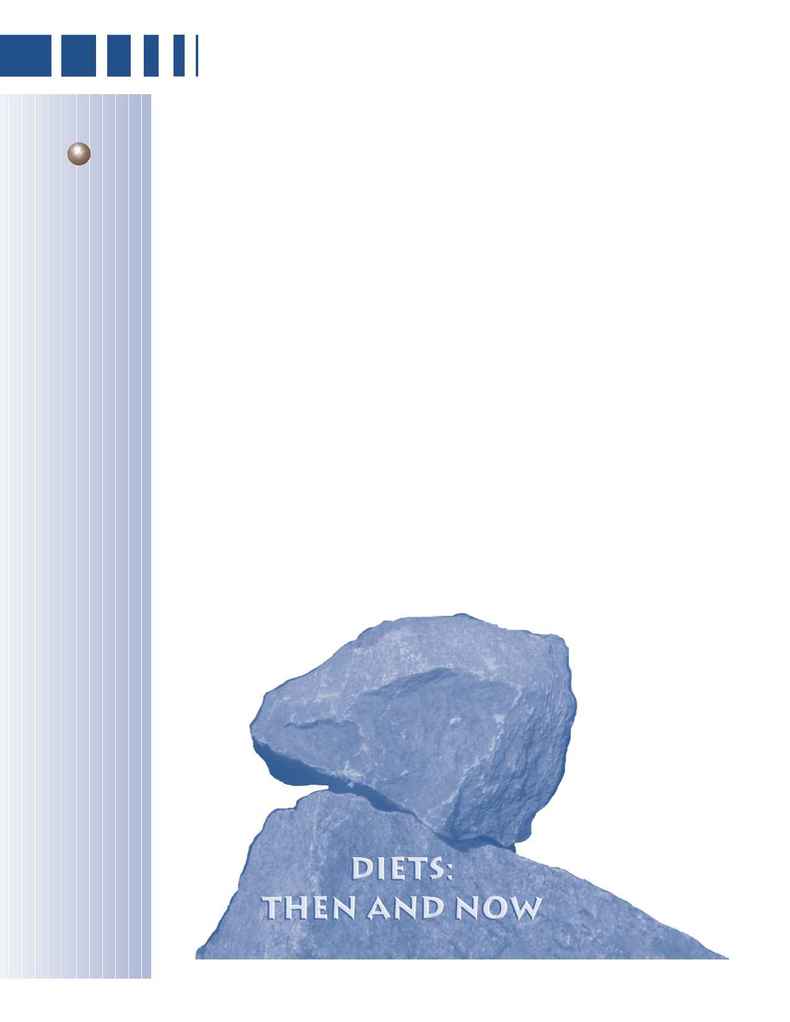
A
8
"Cave Man Cuisine:"
What Can We Learn From Our Ancestors?
recent report from the Centers for Disease
Control and Prevention (CDC) warns that
although overall health has improved and life
expectancy is at a record high, Americans may
be undoing some of these improvements by
increasing their waistlines and participating in
less physical activity.
Despite the warning of increased medical
complications due to overweight and obesity,
including diabetes, heart disease and some
forms of cancer, America's weight problem con-
tinues to swell. New data from the 1999-2000
National Health and Nutrition Examination
Survey indicates that 31 percent of U.S. adults
are obese, compared with 23 percent in 1994.
The highest increase occurred among individu-
als between their late teens and early thirties.
With a 67 percent increase in their obese popu-
lation, the South has seen the most dramatic
change.
Some health professionals believe that some
solutions to society's weight gain woes may be
found in the diets of our ancestors.
Anthropologists such as Neal Smith, author of
"When Culture and Biology Collide," and
Emory Anthropologists Mel
Konner, MD, PhD and S.
Boyd Eaton, authors
of "The
Paleolithic
Prescription," are pursuing an understanding of diets and lifestyles
of the distant past -- those hunter-gatherers who lived during the
Paleolithic period approximately 10,000 - 40,000 years ago.
Although people today may think of our prehistoric ancestors
as club-wielding, small-brained, muscle-bound and posture-chal-
lenged cave men, evidence suggests that our 10,000-year-old
ancestors share a similar physiological profile with the current
generation. Not to mention, they were characteristically healthy.
There was one major difference, however. Obesity and other related
diseases such as cardiovascular disease, hypertension and type 2
diabetes were nearly absent in most ancient populations. An
increasing group of health professionals have directed their
attention to the distant past to determine how these hunter-gatherers
successfully avoided obesity.
The "Cave Man Menu:" Served Everyday 10,000-40,000 Years Ago
Ancient man relied upon hunting and gathering for his primary
diet. Seeds and nuts provided both protien and unsaturated fats
while fruits and vegetables provided the bulk of carbohydrates and
daily caloric intake. Fats from animals and a variety of plants
accounted for 20-25 percent of this ancient diet. Although some
people might assume that ancient man's diet was an explicitly
vegetarian one, meat often contributed to the diets of many ancient
people. However, wild game provided a drastically different nutri-
tional profile than the domesticated cattle of
today. In fact, meat from wild game
is 7-10 times leaner than today's
beef.
Anthropologists and health
professionals theorize that
although the world we live in may
have drastically changed in the
last 10,000 years, human metabo-
lism and digestive systems have
not, which means that current
nutritional demands are designed to
meet those of ancient man. (In terms
of evolution, 10,000 years is a mere
"blink of time" and is insufficient for
"Today our
bodies and lives
are out of step
with each other.
We have genes
that quite
literally belong
to the Stone
Age. But we
have drastically
altered the way
we live and our
biology hasn't
had a chance to
catch up. We're
living longer
than our
ancestors, but
we're dying
from diseases
they never
knew."
-- S. Boyd Eaton,
AUTHOR OF
"T
HE
P
ALEOLITHIC
P
RESCRIPTION
"
Then Now
Fat
20-25%
30-35%
Fiber
100-150 grams 15 grams
Whole Grain
5-6
6-11
Servings
Calories Burned 1,600-2000
400-500
Then Now
Fat
20-25%
30-35%
Fiber
100-150 grams 15 grams
Whole Grain
5-6
6-11
Servings
Calories Burned 1,600-2000
400-500
(continued on page 9)
